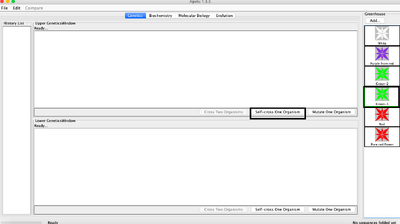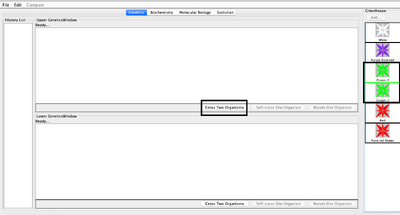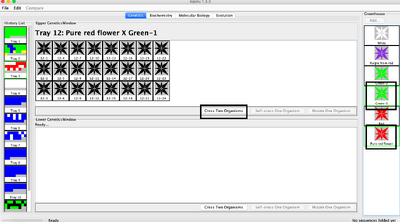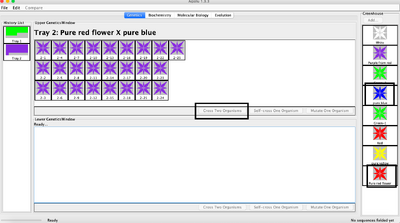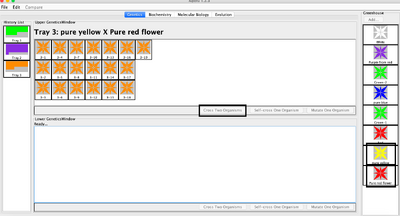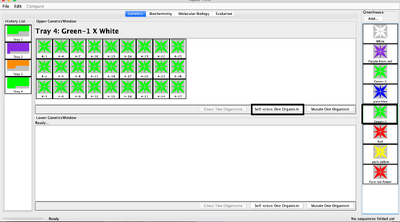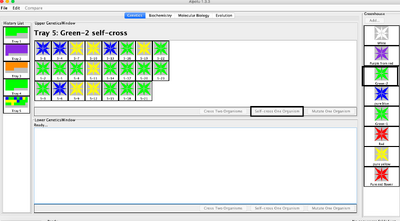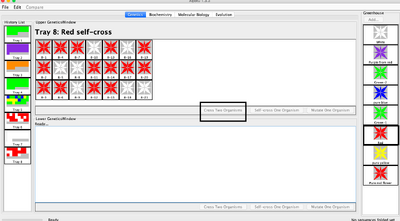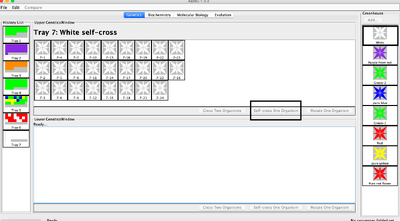Mpaniag1 Week 2
Purpose
The purpose of this lab is to use the model and demonstrate how the hypothetical chief biologist can make a true-breeding purple flower, starting from two green, one red, and one white flower.
Methods/Results (Part 1)
Methods
- Downloaded Aipotu program [1]
- Clicked on the Genetics Tab
- Performed self crosses for the given flowers, Green 1, Green 2, Red, and White
- Performed crosses between each of the given flowers, Green 1, Green 2, Red, and White-i.e. Green 1 with Green 2
- Self crossed every new color that came from crosses-blue, yellow, orange, purple, and black
- Performed backcrosses of all the new colors, a backcross is when you choose a colored flower and cross it with a white flower, i.e. blue and white
- Performed crosses between the new colors (blue, yellow, orange, black, and purple) and the given colors (green 1, green 2, red, and white)
- Performed crosses between yellow and blue
- Performed crosses between red and yellow
- Performed crosses between red and blue
- Performed crosses between black and orange and black and purple to verify which allele was dominant
- Recorded all of the alleles that would produce these phenotypes
- ("Aipotu")
Observations
- Green 1=Green
- Green 2=Yellow+Blue
- Red=Red,White
- Orange=Red+Yellow
- Black=Green+Red
- Blue=Blue
- Yellow=yellow
- Red with green, yellow, or blue provides incomplete dominance
- Green is dominant over yellow and blue
- Green is incompletely dominant with red only
- Orange is Red plus yellow -incomplete dominance
- Black is Green plus Red-incomplete dominance
- White=most recessive
Results
- There are five different alleles.
- CG=Green
- CR=Red
- CB=Blue
- CY=Yellow
- Cr=White
- Dominant Colors
- Green is dominant in most cases, unless when mixed with red, green and red result in incomplete dominance
- Mixing of blue, yellow, or red alleles with each other leads to incomplete dominance
- Recessive
- White
- Colors produced
- CGCG, CBCY, CGCr=Green
- CRCR, CRCr=Red
- CBCB,CBCr=Blue
- CYCY,CYCr=Yellow
- CRCG=Black
- CRCY=Orange
- CRCB=Purple
- Genotypes of Four starting organisms
- Green 1-CGCG
- Green 2-CBCY
- Red-CRCr
- White-CrCr
- A pure breeding purple flower could not be produced because a purple flower is made as a result of incomplete dominance between red and blue
- On MAC a Greenhouse file folder did not exist-no files to add
Questions
page 9
Alleles and their colors
- CG=Green
- CR=Red
- CB=Blue
- CY=Yellow
- Cr=White
Genotype and Phenotype
- CGCG, CBCY, CGCr=Green
- CRCR, CRCr=Red
- CBCB,CBCr=Blue
- CYCY,CYCr=Yellow
- CRCG=Black
- CRCY=Orange
- CRCB=Purple
What rules can you find to explain the color of the data above?
- Incomplete dominance
page 10
Genotypes of Four starting organisms
- Green 1-CGCG
- Green 2-CBCY
- Red-CRCr
- White-CrCr
The flower is purple because CRCR mixed with CBCB and CBCR produces purple
You cannot produce a pure breeding flower using only the four starting strains because purple needs a blue allele
Methods/Results (Part 2-mutations)
- Made a pure breeding strain of red by self crossing the given red flower, then crossing the red flowers produced by the cross until a red flower could self cross and only produce red flowers (took about five rounds)
- Pressed the add button and saved the flower as a Pure Red Strain
- Clicked on the Mutate One Organism Button, after five rounds received a mutated flower, it was purple
- Clicked on the Biochemistry tab, double-clicked on the purple flower resulting from the mutation, compared upper verses lower
- The difference between the two sequences can be seen below
- Clicked on Molecular Biology, double-clicked on the purple flower resulting from the mutation, compared upper verses lower
- The difference between the two DNA sequences can be shown below
- ("Aipotu")
Sahil, Jack, Nick, Maya
- Starting Color-red
- Change in protein sequence
- Top sequence red, bottom sequence blue-->to make a combined color of purple
- Change in DNA
- On MAC does not give access to the greenhouse folder. Will keep the program open to further explore this organism
Scientific Conclusion
In conclusion, it is impossible to make a true-breeding purple flower by crossing the starting strains. A purple flower is made up of a red and blue allele, therefore in a cross you could either get purple, blue, or red flowers. In order to develop a pure-breeding flower a mutation would have to occur in the DNA and amino acid sequence.
Acknowledgements
- I worked with Sahil Patel,Jack P. Menzagopian, and Nicholas D. Yeo during class to organize how the crosses were getting carried out and solve what alleles made which colors and which were the dominant and recessive alleles
- I looked at the pages of Sahil Patel,Jack P. Menzagopian, and Nicholas D. Yeo to see examples of how to format the information given
- I emailed Kam D. Dahlquist, Ph.D. one question to clarify what files should be linked in our results section
- I worked with Madeleine B. King on discussing how to format the journal and clarification on directions/expectations for this journal
- I looked at Christina L. Dominguez's page to learn how to format a picture
- I copied the wiki syntax of Christina L. Dominguez's picture format [[2]]
- I copied and modified the protocol for Genetics from the Aipotu website
- Except for what is noted above, this individual journal entry was completed by me and not copied from another source
Mpaniag1 (talk) 14:53, 29 January 2020 (PST)
References
- Aipotu. (n.d.). Retrieved January 23, 2020, from http://aipotu.umb.edu/
- OpenWetWare. (2020). BIOL368/S20:Week 2. Retrieved January 23, 2020, from https://openwetware.org/wiki/BIOL368/S20:Week_2
Classwork
Assignments
Journals
- mpaniag1 Week 2
- mpaniag1 Week 3
- mpaniag1 Week 4
- mpaniag1 Week 5
- mpaniag1 Week 6
- mpaniag1 Week 7
- mpaniag1 Week 8
- mpaniag1 Week 9
- mpaniag1 Week 10
- mpaniag1 Week 11
- mpaniag1 Week 13
- mpaniag1 Week 14
